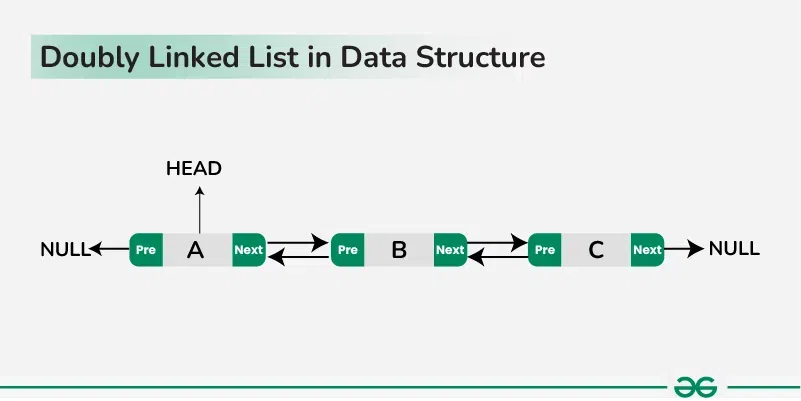Why use a Doubly Linked List?
Last Updated :
18 Mar, 2024
A doubly linked list is a type of data structure that allows for efficient insertion and deletion of elements at both ends. It is beneficial in scenarios where you need to traverse in both directions, and it provides greater flexibility compared to a singly linked list.
 Doubly Linked List
Doubly Linked List
What is Doubly Linked List ?
A doubly linked list is a type of linked list where each node contains a data element and two references or pointers, one pointing to the next node in the sequence and another pointing to the previous node. This allows for traversal in both directions, forward and backward, unlike a singly linked list which can only be traversed in one direction.
Why use a doubly Linked List ?
Here are some scenarios where a doubly linked list is particularly useful:
1. Bidirectional Navigation:
A doubly linked list allows for traversal in both directions, forward and backward. This is useful in applications where you need to navigate back and forth such as in a web browser’s history.
2. Efficient Insertions and Deletions:
In a doubly linked list, insertions and deletions at both ends (front and back) are efficient. They can be done in constant time, O(1), which is beneficial in applications like maintaining a list of high-score entries in a game.
4. Greater Flexibility
A doubly linked list provides greater flexibility. It allows for more complex operations, such as moving forward and backward in the list, or even swapping nodes.
5. Ease of Removal:
Removing a node from a doubly linked list is easier and more efficient because you don’t need to traverse from the head node, as the node to be deleted can access its previous node.
6. Dynamic Data Structures:
Doubly linked lists are used in creating dynamic data structures like heaps, binary trees, and hash tables.
7. Implementation of Advanced Data Structures:
Doubly linked lists serve as the underlying mechanism for the implementation of advanced data structures like Fibonacci heap and Block chain.
8. Reversibility
A doubly linked list can be traversed in both forward and backward directions. In contrast, a singly linked list can only be traversed in a single direction.
Conclusion
In conclusion, a doubly linked list is a powerful data structure that offers several advantages over a singly linked list. It provides bidirectional traversal, efficient insertions and deletions, and greater flexibility. However, it does come with the cost of extra memory for storing the previous pointer. Therefore, the choice between a singly linked list and a doubly linked list will depend on the specific requirements of your program.